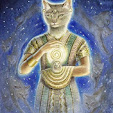Gaetano Donizetti MARIA STUARDA, Royal Opera House Covent Garden, 5 July 2014
Cast
Queen Elizabeth I Carmen Gianattasio
(Elisabetta)
George Talbot, Earl of Shrewsbury Matthew Rose
(Giorgio Talbot)
William Cecil, Lord High Treasurer Jeremy Carpenter
(Guglielmo Cecil)
Robert Dudley, Earl of Leicester Ismael Jordi
(Roberto, Conte di Leicester)
Hanna Kennedy, Maria's maid Kathleen Wilkinson
(Anna)
Mary Queen of Scots . Joyce DiDonato
(Maria Stuarda)
Executioner Peter Dineen
Protestors, Courtiers, Politicians, Crowd
Chorus and Orchestra of the Royal Opera House
Conductor
Bertrand de Billy
Directors
Moshe Leiser and Patrice Caurier
Mary Queen of Scots
Queen Elizabeth I
I will begin by explaining something of the background in case people are not familiar with Schiller's play The opera is a very condensed version of the play, reducing it to a few essential scenes, and of course concentrating on the confrontation between the Queens. The whole first act of Schiller's play is set in Maria's prison in Fotheringay, and contains a scene in which she confronts Paulet, the gaoler, and further scenes in which her own history is gradually revealed - including the fact that she was complicit in the murder of her husband, Darnley.
Donizetti's opera dispenses with all this and starts with what in Schiller's play is the second Act, introducing Elizabeth and her courtiers as she decides whether to accept the marriage proposal of the Dauphin of France - and is faced with a more immediate decision.....what should be the fate of Mary Stuart. The scene ends, as in Schiller, with Leicester urging her to agree to meet with Maria.
The compression means that the open of Scene II is our FIRST introduction to Maria: the scene begins with her thinking nostalgically of her happy childhood in France. Elizabeth and her entourage arrive almost immediately, and it is now that the confrontation takes place - with disastrous consequences for Maria.
Schiller's final scene is also omitted, and the opera ends with Maria's execution. Schiller's dramatic purpose was rather different from Donizetti's - our sympathies are with Maria, BUT at the end Elizabeth is left alone, everyone has deserted her, even Leicester, and Lord Shrewsbury resigns as her Chancellor. She has done what she had to do, but it has cost her everything.
So after this short preamble - what of last night's performance? It was a stunning triumph for Joyce DiDonato, and both she and Carmen Giannatasio shone in the confrontation scene - the point is that Maria throws her life away for the sake of insulting Elizabeth, and DiDonato's Maria obviously felt that it was worth it! I will never forget the soaring high notes on which she sang 'Vil bastarda!' Or the venom with which Elizabeth responds that Maria has effectively signed her own death warrant.
Donizetti has reduced the number of male characters, and the ones that remain are also rather undifferentiated - I imagine this must have been his intention, in order to focus on the rival queens. This being said, I found that all three male characters that remain were well performed, with Matthew Rose as a sympathetic Talbot, Ismael Jordi as Leicester a smooth-voiced tenor.
The execution scene is the scene is which the mezzo-soprano really comes into her own, it has all been building up to this. I especially loved her rendering of the Confession. (Quando di luce rosea/il giorno a me splendea....) This is why Donizetti omits Schiller's last scene, as he didn't want to divert attention from the vocal splendours and pathos of the execution scene.
I will say a few words about the staging, as it has given rise to a certain amount of controversy. Well actually it gave rise to an absolutely disgraceful outbreak of booing, which was completely unjustified. It isn't a brilliant production - it is minimalist, and I like this as it enables us to concentrate on the psychological drama and the interaction between the protagonists - the confrontation between the Queens is the high point of the opera, and we don't need to be distracted from that.
The stage is almost bare, and everyone except the two Queens is in modern dress. This is another way of underlining their status as heroines.....but also their isolation.
As you can see here, Elizabeth has removed her wig - this is a reference to the historical Elizabeth, who towards the end of her life did always appear in public wearing a red wig and an elaborate farthingale - like many absolute monarchs, inspiring her subjects with respect.
As I've already indicated, Donizetti reduced the number of male characters, and here they appear as 'men in suits'.
Mary's prison is even more sparse, and the execution chamber does present a bleak aspect - surely it SHOULD look like this, with the harsh light falling on the victim!
The execution scene also contained a poignant touch of realism - Maria is made to discard her heavy velvet dress, so she is standing there in her shift, and then the executioner CUTS HER HAIR - this is so sad, as she stands there feeling her bare neck.
So I was really shocked and horrified when the booing started - the boos were directed at the production team, as everyone had, quite rightly, been loud in their applause for the performance, especially for the heroine of the evening, Joyce DiDonato. It wasn't a bad production, although it wasn't brilliant either - it was designed to emphasise the salient points of this psychological drama, and worked reasonably well. I tried to remonstrate with one of the ringleaders, but to no avail.
My advice then? Go to HEAR this anyway, even if you don't want to SEE it!!














